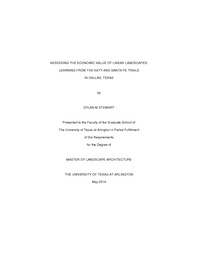| dc.description.abstract | This research is an economic value study for linear landscapes. Additionally, the research builds upon relevant landscape architecture literature in concern to the economic value of landscape. Specifically, the focus occurs upon a landscape typology that is relevant to today's design practice (Crompton, 2001; Brander et.al, 2011; Sherer, 2006). The research's relevancy stems from the landscape architect's ability to analyze and understand dynamic, linear landscapes as they stimulate economic activity beyond their direct footprint (see such as Vandermeulen et al., 2011; Ozdil, 2008; Tzoulas et al., 2007; de Groot et al., 2002; Quayle, 1995).The purpose of this research is to assess the economic value of linear landscapes in the urban setting through the study of Katy and Santa Fe Trails in Dallas, Texas. Linear landscape, as a term, derives from relevant literature in concern to parks and open spaces with linear qualities. Specifically, the term builds upon the typologies of urban trails, linkages, greenways and green infrastructure (see such as Tzoulas, 2007; Walmsley, 2001; Wright; 2013 and so on). This research derives from the landscape architect's ability to understand unique landscape typologies, utilize research to understand relevant precedents and to implement a research method strategy to understand the economic value of linear landscapes through geo-spatial analysis.The research follows quantitative methods to assess the economic value of linear landscapes. For the research methods, first, the literature review informs the collection and distillation of economic value indicators through the study of land development and landscape architecture case studies (Francis, 1999; LAF, 2014; ULI, 2014). Second, the data collection process utilizes open record requests and/or government data sharing sources (for example, US Census, 2014). This procedure promotes a replicable data collection format. Third and finally, the geo-spatial data analysis occurs in Geographic Information Systems (GIS) (Esri, 2014) to understand the economic value on-site, along the adjacencies and within the urban fabric.In conclusion, the data analysis outlines different growth patterns for adjacent development and the urban context within 0.25 mile radius from the Katy and Santa Fe Trails in Dallas Texas. Of note, the linear landscapes display immediate impact (within first five years of inception) in economic value. Specifically the impact is through the indicators of property values, sales tax generated, and number of jobs and establishment. The research illustrates that the utilization of replicable research methods and accessible data sources helps to understand the unique impact of linear landscapes. This topic is relevant due direct and indirect impact urban landscapes, especially linear landscapes, stimulate within their urban context. | en_US |


